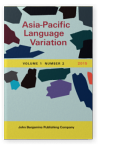Professor Sibata’s haha and other sociolinguistic insights
Takesi Sibata, the pioneer of sociolinguistic dialectology, anticipated several developments that we now apply internationally in the discipline of sociolinguistics. I outline Professor Sibata’s accomplishments from a Western perspective, but I am mainly interested in promoting wider appreciation of his work in the study of language variation. To do that, I review some of his analyses and show how Professor Sibata developed concepts that persist in contemporary sociolinguistics. I show that, for instance, about fifteen years before the inception of Western sociolinguistics, Professor Sibata was already engaged in studying sound change in apparent time, identifying linguistic innovators, eliciting folk concepts about dialects, and seeking empirical evidence for the critical period in dialect acquisition, as well as other pursuits that are now integral to our discipline.
References
Chambers, Jack K
(
2009)
Sociolinguistic theory: Linguistic variation and its social significance (3rd ed.). Oxford, UK; Malden, US: Wiley-Blackwell.

Chambers, Jack K
(
2007)
Sociolinguistics. In
George Ritzer (Ed.),
The Blackwell encyclopedia of sociology, Vol. IX1 (pp. 4593–4596). Oxford, UK: Blackwell. Retrieved February 20, 2015, from
[URL].


Chambers, Jack K
(
1992)
Dialect acquisition.
Language, 681, 673–705.


Chambers, Jack K., & Trudgill, Peter
(
1980)
Dialectology. Cambridge, UK: Cambridge University Press. (2nd edition 1998)

Gould, Peter, & White, Rodney
(
1974)
Mental maps. Harmondsworth: Penguin.


Kunihiro, Tetsuya, Inoue, Fumio, & Long, Daniel
(Eds.) (
1999)
Takesi Sibata: Sociolinguistics in Japanese contexts. Berlin: Mouton de Gruyter.


Labov, William
(
1972)
Sociolinguistic patterns. Philadelphia: University of Pennsylvania Press.

Linn, Michael D
(
1996)
Introduction: Papers from the special session in honor of Professor Takesi Sibata.
American Speech, 711, iii.

Milroy, James, & Milroy, Lesley
(
1985)
Linguistic change, social network and speaker innovation.
Journal of Linguistics, 211, 339–384.


Nagase, Jiro
(
1996)
The role of student-club members in the process of word spread.
American Speech, 711, 136–141.


Niedzielski, Nancy, & Preston, Dennis R
(
2000)
Folk linguistics. Berlin; New York: Mouton de Gruyter.


Preston, Dennis R
(
2011)
The power of language regard: Discrimination, classification, comprehension and production.
Dialectologia, 21, 9–33.

Preston, Dennis R
(
2010)
Mapping the geolinguistic spaces of the brain. In
Alfred Lameli,
Roland Kehrein, &
Stefan Rabanus (Eds.),
Language and space: An international handbook of linguistic variation (pp. 121–141). Berlin: De Gruyter Mouton.


Preston, Dennis R
(
1981)
Perceptual dialectology: Mental maps of United States dialects from a Hawaiian perspective. In
Henry Warkentyne (Ed.),
Methods IV: Papers from the 4th International Conference on Methods in Dialectology
(pp. 192–198). Victoria, BC: University of Victoria.
Sibata, Takesi
(
1977)
Nihonjin no gengoseikatsu [The language life of the Japanese].
Iwanami Kôza Nihongo, 21, 33–81. (Reprinted in
Sociolinguistics in Japanese contexts, pp. 19-50, by Tetsuya Kunihiro, Fumio Inoue, & Daniel Long, Eds., 1999, Berlin; New York: Mouton de Gruyter)

Sibata, Takesi
(
1971)
Kotoba no kihanishiki [Consciousness of language norms].
Gengo Seikatsu, 2361, 14–21. (Reprinted in
Sociolinguistics in Japanese contexts, pp. 371-377, by Tetsuya Kunihiro, Fumio Inoue, & Daniel Long, Eds., 1999, Berlin; New York: Mouton de Gruyter)

Sibata, Takesi
(
1960)
Ryûkôgo to gengobosu [Fad words and language bosses].
Gengo Seikatsu, 1051, 16–24. (Reprinted in
Sociolinguistics in Japanese contexts, pp. 309-320, by Tetsuya Kunihiro, Fumio Inoue, & Daniel Long, Eds., 1999, Berlin; New York: Mouton de Gruyter)

Sibata, Takesi
(
1959)
Hôgenkyôkai no ishiki [Consciousness of dialect boundaries].
Gengo Kenkyu, 361, 1–30. (Reprinted in
A handbook of perceptual dialectology, pp. 39-62, by Dennis R. Preston, Ed., 1999, Amsterdam: John Benjamins)

Sibata, Takesi
(
1958)
Nihon no hôgen [
The dialects of Japan]. Tôkyô: Iwanami.

Sibata, Takesi
(
1951)
Gengochiikishakai no kenkyû to sonohôhô [The survey of a speech community and its methodology].
Kokugo-gaku, 71, 28–43.(Reprinted in
Sociolinguistics in Japanese contexts, pp. 51-63, by Tetsuya Kunihiro, Fumio Inoue, & Daniel Long, Eds., 1999, Berlin; New York: Mouton de Gruyter)

Sibata, Takesi, & Suzuki, Taka
(
1959)
‘Haha’ to yuuyooni narumade [Learning to say
haha
].
Gengo Seikatsu, 981, 32–39. (Reprinted in
Sociolinguistics in Japanese contexts, pp. 127-142, by Tetsuya Kunihiro, Fumio Inoue, & Daniel Long, Eds., 1999, Berlin; New York: Mouton de Gruyter)

Cited by
Cited by 1 other publications
Stanford, James N.
2016.
A call for more diverse sources of data: Variationist approaches in non‐English contexts.
Journal of Sociolinguistics 20:4
► pp. 525 ff.

This list is based on CrossRef data as of 23 april 2024. Please note that it may not be complete. Sources presented here have been supplied by the respective publishers.
Any errors therein should be reported to them.
